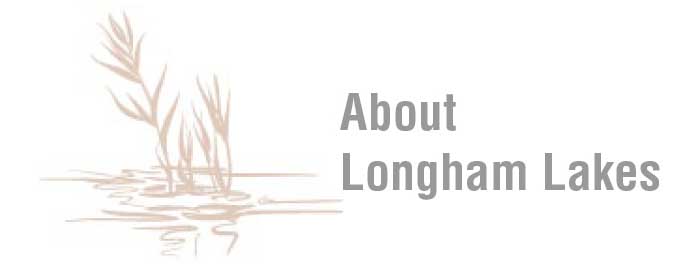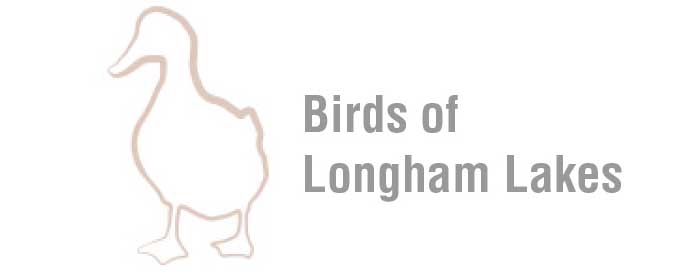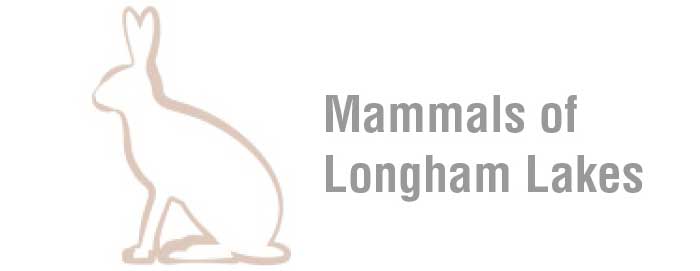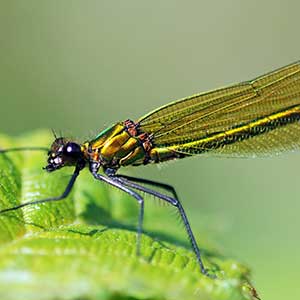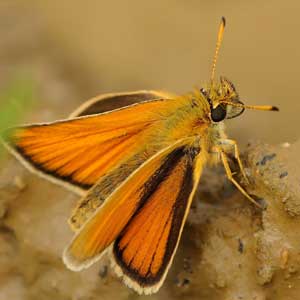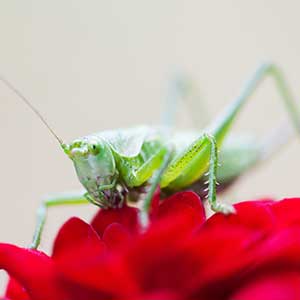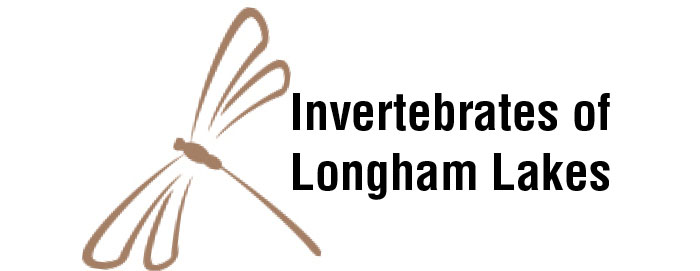
Invertebrates of Longham Lakes
DAMSELFLIES AND DRAGONFLIES – ODONATA
BANDED DEMOISELLE
Calopteryx splendens
Generally common along slow-flowing rivers in England. Main flight period May-August.
At Longham, common along the river margins, where it breeds, and frequently encountered at the nearby reservoir margins.
First recorded summer 2008 during survey work (Steve Morrison.)
2015: Small numbers present on 17th, 25th & 29th June (George Green.)
2016: 11th June; 26th June. Present 28th May-9th July (George Green.)
2017: 6th July; 9th July. Present from 1st June to 15th July (George Green.)
2018: 14th May; 27th May; 8th August.
AZURE DAMSELFLY
Coenagrion puella
Very common in a wide range of standing waters. Main flight period May-September.
At Longham, common along the river and reservoir margins, also common in both small ponds at southern end. Breeds.
2016: Present on 9th June.
2017: 9th July. Present from 28th May to 10th July (George Green.)
2018: 14th May.
COMMON BLUE DAMSELFLY
Enallagma cyathigerum
An abundant damselfly found almost everywhere. Main flight period May-September.
At Longham, common along the river and reservoir margins, also common in both small ponds at southern end. Breeds.
First recorded summer 2008 during survey work (Steve Morrison.)
2014: 3 on 3rd October.
2015: Present 13th June-26th August (George Green.)
2016: Present 5th June-24th September (George Green.)
2017: 21st June; 6th July; 9th July. Present from 28th May to 15th September (George Green.)
2018: 4th May; 14th May; 6th August; 8th August
RED-EYED DAMSELFLY
Erythromma najas
Fairly common on lakes, gravel pits, canals and slow-flowing rivers. Main flight period May-September.
Although overlooked until 2012, this species in common at Longham along the sides of both reservoirs, and also on the two south-western ponds.
2012: 9th and 12th August.
2015: 4 on 18th July. Small numbers present 15th July-2nd August (George Green.)
2016: Present 5th June-6th August (George Green.)
2017: 21st June; 6th July; 9th July. Present from 28th May to 4th July (George Green.)
2018: 14th May; 10+ on 15th May; 2 on 13th June; 14th July.
SMALL RED-EYED DAMSELFLY
Erythromma viridulum
Uncommon recent colonist, first recorded in Britain in 1999. On ponds, lakes and ditches with floating vegetation. Main flight period June-September.
First recorded at Longham on 9th August 2012 (George Green). Now well established, commonest on the small ponds south of the main reservoir, but also present on the larger reservoirs.
2012: 9th August.
2014: 8th August.
2015: 12th July; 16+ individuals, including 5 pairs egg-laying or mating (Olly Frampton). Small numbers present 9th-31st July (George Green.)
2016: 6th July; 16th July. Present 6th July-26th August (George Green.)
2017: 30th June; 4th July; 6th July; 8th July; 9th July; 11th August. Present from 30th June to 15th August (George Green.)
2018: 24th June; 3rd July; 6th July.
BLUE-TAILED DAMSELFLY
Ishnura elegans
Widespread and common in many habitats. Main flight period April-September.
At Longham, common along river and reservoir margins and in both small ponds on the south-west. Breeds.
First recorded summer 2008 during survey work (Steve Morrison.)
2015: Present 25th June.
2016: Present 26th June.
2017: 21st June; 6th July; 9th July. Present from 28th May to 13th August (George Green.)
2018: 6th August.
LARGE RED DAMSELFLY
Pyrrhosoma nymphula
Common and very widespread in various wetlands, small to large. Main flight period April-August.
At Longham, common along the river and reservoir margins. Breeds.
2018: 4th May; 10th May; 14th May.
WHITE-LEGGED DAMSELFLY
Platycnemis pennipes
A locally common damselfly of slow-flowing muddy rivers. Main flight period June-July.
At Longham, common along the river margins and around inland scrub. Breeds. Sometimes wanders to the margins of the reservoirs.
First recorded summer 2008 during survey work (Steve Morrison.)
2016: 16th July.
2017: One on 23rd June; 2 on 8th July; 9th July.
2018: 6th June (1); 13th June (1); 18th June; 22nd June; 24th June (1); 3rd July (1).
SOUTHERN HAWKER
Aeshna cyanea
Very common in the south of Britain around well-vegetated standing waters. Main flight period June-October.
Fairly common around the reservoirs and ponds, ranging widely. Possibly breeds.
2012: 27th September (1).
2013: 14th August (2).
2016: At least 1 on 26th August.
2018: 4th August (1); 6th August (1); 8th August; 14th August.
BROWN HAWKER
Aeshna grandis
Common in a variety of slow-flowing or standing waters, mainly in the south. Main flight period July-September.
Common around the whole site and probably breeds on the reservoirs.
2015: 18th July (3). Present 31st July-27th August (George Green.)
2016: Present 6th August-12th September (George Green.)
2017: 30th June; 6th July; 9th July. Present from 30th June to 9th September (George Green.)
2018: 22nd June; 29th June (1); 6th August (20); 8th August; 14th August; 20th August (1).
MIGRANT HAWKER
Aeshna mixta
Common on well vegetated lakes and other wetlands. Continental migrants may boost the population in late summer. Main flight period August-October.
At Longham, frequently seen around the site, with males often patrolling discrete areas. Possibly breeds.
2012: Lots on 27th September.
2013: Lots on 22nd September.
2015: Present on 26th August and 2 late individuals on 4th November, including one eating a bumblebee! (George Green.)
2016: Present 15th August-30th September (George Green.)
2017: Present from 28th August to 26th October (George Green.)
2018: 14th August; 20th August (1).
EMPEROR DRAGONFLY
Anax imperator
Common in many types of well-vegetated wetlands with still or slow-flowing water. Main flight period May-August.
Common around the reservoir margins and the southern ponds. Breeds.
First recorded summer 2008 during survey work (Steve Morrison.)
2012: 12th August.
2014: 16th August (1), 3rd October (2)
2015: Present 17th June-31st July (George Green.)
2016: Present 21st June-26th August (George Green.)
2017: 20th June; 6th July; 9th July; 14th August (1). Present from 15th June to 17th August (George Green.)
2018: 21st May (1); 23rd May; 25th May; 27th May (1+); 6th June (several); 18th June (5); 24th June; 9th July; 6th August; 14th August.
LESSER EMPEROR
Anax parthenope
A rarity to the UK, but something of a Longham special. Annual; first recorded in Britain in 1996. Main flight period July-September, on ponds and lakes.
First recorded at Longham in August 2012.
2012: 9-12th August (George Green.)
2017: A male on 20th June, 2 males on 21st June; 1+ males on 6th July; 3 on 8th July; 1+ on 9th July; 1 on 12th July; 1+ on 17th July.
2018: 15th June (1); 24th June (1); 25th June; 29th June; 30th June; 3rd July; 6th July (1); 9th July; 19th July (pair copulating); 21st July (1).
HAIRY DRAGONFLY
Brachytron pratense
Generally uncommon in Britain, although extending its range. Requires rank vegetation close to slow-moving water. Main flight period May-July.
At Longham, probably overlooked previously, and first recorded on 14th May 2018 by Matthew Bell.
2018: 14th May (1); 15th May (6+, pair copulating) (Olly Frampton); 18th May (2+); 20th May (1); 21st May (6 males, 3 females); 22nd May (2); 23rd May (5); 25th May (1 male); 6th June (1).
GOLDEN-RINGED DRAGONFLY
Cordulegaster boltonii
Common, but breeds on acid rivers and streams, wandering to heathland. Main flight period May-September.
Uncommon visitor to the site. Records include the following:
2015: Singles on 29th June & 15th July (George Green.)
2016: 16th July (1).
2017: 21st June; 9th July; 10th August; 11th August.
2018: 13th June (1); 22nd June; 29th June (1); 3rd July (1).
DOWNY EMERALD
Cordulia aenea
Uncommon and scattered. Generally found in ponds close to deciduous woodland, with bankside trees and sparse stands of emergent vegetation. Main flight period May-July.
A male on the south-west pools on 14th May 2018 (Matthew Bell) and seen for the next few days was hardly expected, although there were other records of wanderers elsewhere at the same time.
2018: 14th May (1); 21st May (1); 22nd May (1).
BROAD-BODIED CHASER
Libellula depressa
Mainly found on smaller ponds, ditches and small lakes with standing water. Main flight period May-July.
Fairly common around the reservoir margins and south‐west ponds. Breeds.
2017: 2 on 14th August.
2018: 27th May (1); 6th June (1); 18th June (3).
SCARCE CHASER
Libellula fulva
Localised in southern Britain on neutral or base-rich slow-flowing rivers in flood-plains and water-meadows. Thrives where there is dense emergent and marginal vegetation. Main flight period May-June.
Frequently encountered along the river margins and also found sunning along the
hedgerows in the west part of the site. Breeds in the river and may also do so in the reservoirs.
2008: First recorded during survey work in summer (Steve Morrison.)
2015: 23rd May (1); 9th July; 12th July (1).
2016: 19th May; at least 5+ on 9th June; 11th June; 1 on 18th June; 16th July.
2017: 20th June; 21st June; 30th June; 9th July. Present in small numbers from 20th May to 30th June (George Green.)
2018: 20th May (1); 22nd May (1); 23rd May (3); 25th May (3+); 6th June (1); 18th June (4+); 22nd June; 24th June (9+); 6th July.
FOUR-SPOTTED CHASER
Libellula quadrimaculata
Occurs in a wide range of standing waters although favours acidic pools best, Main flight period May-August.
Infrequently noted at the main ponds south‐west of Longham Reservoir South. Breeds.
2015: 29th June.
2018: 14th May; 15th May (2); 20th May (4); 21st May (4); 22nd May; 25th May (2+); 6th June (2); 18th June (2).
BLACK-TAILED SKIMMER
Orthetrum cancellatum
Fairly common to abundant in lowland ponds, lakes and gravel pits. Main flight period June-July.
Now abundantly seen around the reservoirs and main pond south‐west of Longham Reservoir South. Often noted sunning on bare ground.
2014: 20th June (2).
2015: 14th July; 18th July. Present 13th June-2nd August (George Green.)
2016: Present 5th June-26th August (George Green.)
2017: 21st June; 1st July; 6th July; 9th July. Present 1st June to 17th August (George Green.)
2018: 23rd May; 24th June; 6th August; 8th August.
KEELED SKIMMER
Orthetrum coerulescens
Scarce over acidic wet heathland sites, but sometimes found in less acidic conditions. Main flight period June-August.
Likely to be only a casual visitor to the site.
2008: Infrequently seen around the main pond south‐west of Longham Reservoir South (Steve Morrison.)
SCARLET DARTER
Crocothemis erythraea
A very rare migrant since the first in Britain in 1995, with records nationally falling between mid-June to early September. Found on shallow, still waters.
2017: One turned up at Longham Lakes on 8th and 9th July (Martin Wood.) It was only the 8th for Britain and the first for 13 years.
RED-VEINED DARTER
Sympetrum fonscolombii
An irregular but annual migrant, particularly to southern England. Found in warm, still waters, often shallow. Main flight period July-August.
2009: Seen in May in the Gravel Pit during survey work (Steve Morrison.)
2017: 3, including a copulating pair on 19th June (George Green); 2 on 20th June; many on 21st June; 1 on 30th June; 1 on 4th July; 1+ on 6th July; 9th July; 2 on 12th July; 1+ on 13th July.
COMMON DARTER
Sympetrum striolatum
A common and widespread late summer species, occurring in many different habitats. Main flight period July-October.
Common around the lake and pond margins where it breeds. Frequently seen sunning on bare ground.
2013: 10th November (1).
2015: Present 31st July-26th August (George Green.)
2016: Present 3rd-11th August (George Green.)
2017: 9th July. Also present from 4th August to 20th October (George Green.)
2018: 21st July; 8th August.
BUTTERFLIES – LEPIDOPTERA (PART)
SMALL SKIPPER
Thymelicus sylvestris
Common and widespread, particularly in open areas with plenty of grasses such as Yorkshire Fog. Main flight period June-August.
At Longham, common on grassland and around the edges of hedgerows.
ESSEX SKIPPER
Thymelicus lineola
Fairly common in southern England in tall, dry grassland in open, sunny situations. Main flight period July-August.
At Longham, either uncommon or overlooked. First noted in 2017.
LARGE SKIPPER
Ochlodes sylvanus
Common in habitats with tall, rough grass. Main flight period June-August.
Frequent and recorded on grassland and along the edges of hedgerows.
CLOUDED YELLOW
Colias croceus
Regular annual migrant that can be seen anywhere. More numerous in some years than others. Appears in May, August and again in late autumn right through into winter.
Uncommon migrant to Longham.
BRIMSTONE
Gonepteryx rhamni
Common in scrubby woodland and hedgerow, wherever buckthorn grows. Main flight periods February-May and then August-September.
Fairly common around the site, especially the woodlands.
LARGE WHITE
Pieris brassicae
Abundant just about anywhere. Flight periods April-June and July-October.
Common and widespread all around the site.
SMALL WHITE
Pieris rapae
Abundant just about anywhere. Flies pretty much any time between late March and October, sometimes later.
Common and widespread around the site, especially the woodland/scrub borders.
GREEN-VEINED WHITE
Pieris napi
Common wherever there is damp, lush vegetation, including hedgerows and riverbanks. Flight periods April-June and late July-September.
ORANGE-TIP
Anthocharis cardamines
A classic spring butterfly of damp, grassy habitats, including woodland and verges. Main flight period April-June, with some second broods in late July and early August.
Fairly common in the woodland sections of the site, particularly Emily’s Wood.
HOLLY BLUE
Celastrina argiolus
Common in a variety of habitats including woodland, hedgerows and gardens. Main flight periods March-May and July-September, with some hanging on later in the autumn.
A common butterfly around the site, often seen only on the wing.
BROWN ARGUS
Aricia agestis
A fairly common species of grassland and verges, found in small colonies. Main flight period April-June and then July-September.
COMMON BLUE
Polyommatus icarus
Common in sunny, sheltered locations wherever the foodplant, Birdsfoot Trefoil, present. Flight periods May-June and July-October.
Common and perhaps increasing as the amount of grassland verge on the site has magnified.
SMALL COPPER
Lycaena phlaeas
Common in many habitats, especially warm, dry areas including verges and woodland rides. Flies almost continuously from April to October in several generations.
RED ADMIRAL
Vanessa atalanta
An abundant butterfly almost everywhere. Almost entirely an immigrant from the Continent each year, commonest in the autumn. Flight period any time from late February to early November.
Very common around the site in most summers.
100 seen in a day on the nettlebeds by the watermeadows during the ecological survey of 2016.
PAINTED LADY
Vanessa cardui
An immigrant butterfly that flits between being common one year and rare the next. Found in many habitats but particularly favours open, rough, dry areas. Flight period any time between April and October, occasionally in winter.
Uncommon migrant to Longham, recorded once or twice most years.
SMALL TORTOISESHELL
Aglais urticae
A very widespread and common butterfly, much more numerous in some years than others. Overwinters as an adult, so can genuinely be seen in any month of the year, although most frequently from February to September.
Generally not very common on site, mainly on nettles in the southern (private) section by the watermeadows.
PEACOCK
Inachis io
A gaudy and very common butterfly, often found around favoured nectar plants such as buddleia, teasels, thistles and willow blossom. It also requires nettle patches. Potentially flies in any month of the years as it overwinters as an adult, but most likely between February and September.
Frequently found in suitable habitat such as bramble patches and nettle-beds.
COMMA
Polygonia c-album
Common in open woodland, woodland edges and gardens. It overwinters as an adult, so is sometimes seen in early spring, even February. Otherwise may be seen all summer long with a resurgence in September.
Fairly frequent on bramble flowers around the site and at nettle patches on the watermeadows.
MARBLED WHITE
Melanargia galathea
A fairly common southern species mainly associated with unimproved grassland, but also roadside verges and other grassy habitats. Main flight period June-August.
Often present in good numbers on the grasslands.
SPECKLED WOOD
Pararge aegeria
A common butterfly of woodland, woodland edge and hedgerows. Overlapping broods ensure that it can be seen any time between April and October.
Frequently encountered in the woodlands on-site and along scrub margins.
GATEKEEPER
Pyronia tithonus
This is a classic edge and hedge species, usually found in shrubby areas. It has a short flight period from mid-July to the end of August.
Common at all hedgerows and scrub borders, often encountered feeding at bramble flowers.
MEADOW BROWN
Maniola jurtina
An abundant butterfly of all manner of open habitats, including everything from grassland to woodland rides and gardens. Main flight period June and July, with some hanging on right into the autumn.
Common on all rank grasslands and meadows on site.
RINGLET
Aphantopus hyperanthus
Common in lush, tall grasslands, often on heavy soils and especially in scrubby areas. Main flight period July and early August.
Frequent on the meadow adjoining Samuel’s Wood and bordering scrub.
Recorded there in the survey of 2016.33.
SMALL HEATH
Coenonympha pamphilus
Mainly found on dry, well-drained grassland sites, but also adapts to verges and other open places. Main flight periods May-July and August-October.
Frequently seen on grassland.
Recorded on the grassland south of the main lake in the survey of 2016.
GRASSHOPPERS AND CRICKETS – ORTHOPTERA
GREAT GREEN BUSH‐CRICKET
Tettigonia viridissima
Common in overgrown hedges, bramble and bracken. Adults present from late July until early winter.
At Longham, frequently located in light scrub and bramble patches.
Recorded in surveys in Summer 2016.
DARK BUSH‐CRICKET
Pholidoptera griseoaptera
Found in wasteland, bramble thickets, old hedges, woodland edges and rides, thickets on sea cliffs and scrub on the edges of saltmarshes and dunes. Adults appear in late June to early July and survive until winter.
At Longham, common in hedgerow, scrub and bramble patches.
Recorded in the surveys in 2008 and 2016.
ROESEL’S BUSH‐CRICKET
Metrioptera roeselii
A species of damp meadows and grassland currently expanding its range west and north to urban wasteland and agricultural set-aside. Adults present from late July until autumn.
At Longham, frequent in long grass.
Recorded in the 2016 survey.
LONG‐WINGED CONEHEAD
Conocephalus discolor
Found in coarse vegetation in ungrazed downland, urban wasteland, coastal reedbeds, dry heaths and bogs. Adults present from August until early winter.
At Longham, frequent in long grass.
Recorded in the surveys in 2008 and 2016.
SHORT‐WINGED CONEHEAD
Conocephalus dorsalis
Mainly a species of saltmarsh, but also found in reedbeds at inland sites.
At Longham, found by the small pools at the south end of South Lake.
Found on 12th July 2015 (James Phillips.)
SPECKLED BUSH‐CRICKET
Leptophyes punctatissima
Found in open woodland, scrub, gardens and hedgerows. Adults present from late July or early August until November.
At Longham, common in hedgerow, scrub and bramble patches.
Recorded in the 2016 survey.
SLENDER GROUNDHOPPER
Tetrix subulata
Bare mud and short vegetation in damp, unshaded locations. Nymphs appear from May to July; adults appear by August.
At Longham, common in patches of bare soil.
Found in the 2008 survey only.
COMMON GROUNDHOPPER
Tetrix undulata
Open habitat with bare ground and short vegetation but unlike T. subulata and T. ceperoi it occurs in both wet and dry locations. Presence of moss is important. Adults may be found at any time of the year.
At Longham, infrequent in patches of bare soil.
Found in the 2008 survey only.
COMMON GREEN GRASSHOPPER
Omocestus viridulus
Common in long grass, often in damp situations and particularly old, unimproved grasslands which are not heavily grazed or mown. Adults appear from July and survive into November.
At Longham, infrequently found in patches of long grass.
Recorded in the 2016 survey.
FIELD GRASSHOPPER
Chorthippus brunneus
Common in short vegetation in dry, sunny situations. Adults appear from June and may survive until early December.
At Longham, fairly common in areas of short grassland throughout the site.
Recorded in the surveys in 2008 and 2016.
MEADOW GRASSHOPPER
Chorthippus parallelus
Common in coarse grasses in a wide range of habitats such as woodland rides, roadside verges, waste ground, valley wetlands and wet grassy moorland. Adults appear by June and remain abundant through to September, some may survive into November.
At Longham, fairly common in all areas of grassland throughout the site.
Recorded in the surveys in 2008 and 2016.
LESSER MARSH GRASSHOPPER
Chorthippus albomarginatus
Found in a wide range of rough grassy areas, often with sedges and grassy embankments. Adults appear from early to mid-July and remain abundant through to October.
At Longham, common along the margins of both reservoirs and in the watermeadow.
Recorded in the 2016 survey.
No Results Found
The page you requested could not be found. Try refining your search, or use the navigation above to locate the post.

